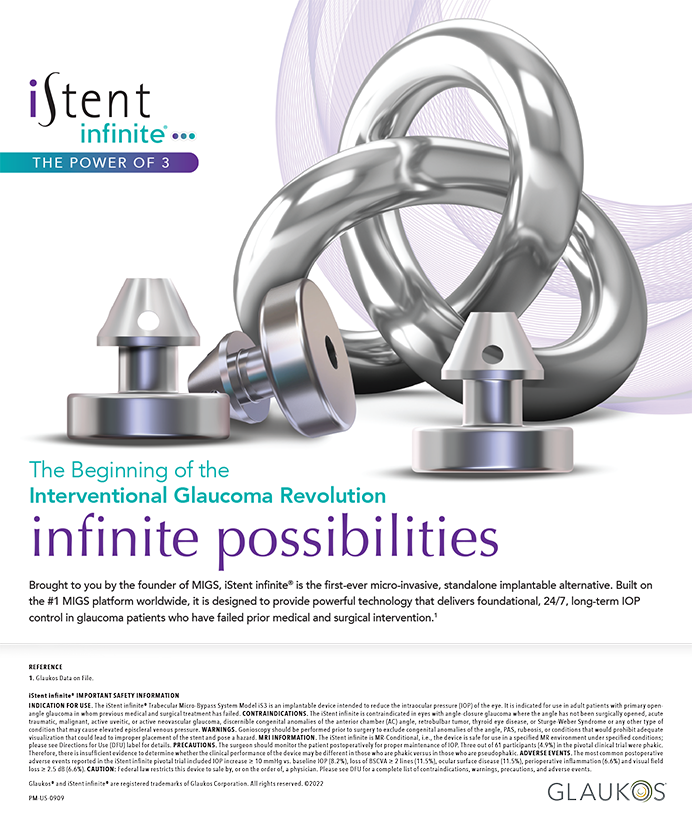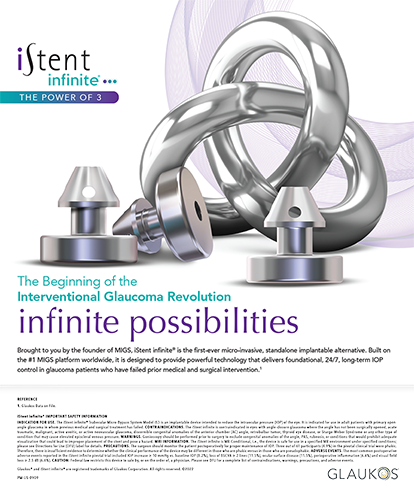A large percentage of the people presenting for cataract surgery have visually significant astigmatism. A recent analysis of corneal cylinder concluded that more than 36% of the population has at least 1.00 D of astigmatism1 and another found that 41% have 0.75 D or more.2
For good uncorrected distance vision, we surgeons must achieve a refractive result of less than 0.75 D of astigmatism. In truth, I want to get that amount as close to zero as possible. Studies have shown that astigmatism of as little as 0.50 D can reduce visual acuity by 1 line and that its impact on dynamic, functional visual acuity and low-contrast acuity is even greater.3 Moreover, ocular surface problems and computer usage—both common in the cataract population— magnify the impact of even minimal residual astigmatism on patients' ocular comfort and performance.4-6
For low levels of astigmatic correction, limbal relaxing incisions or laser arcuate incisions at the time of cataract surgery may suffice. In many cases, however, a toric IOL represents the best option for full correction.
Canadian surgeons such as myself have access to a number of toric lenses, including the AcrySof Toric (Alcon Laboratories, Inc.), the STAAR Toric (STAAR Surgical Company), the Rayner T-Flex Toric (Rayner Intraocular Lenses Ltd.), the Zeiss Acri.Lisa Toric, and the Tecnis Toric (Abbott Medical Optics Inc.; Figure 1). This article examines five pieces of conventional wisdom about the implantation of toric IOLs that may not serve us (or our patients) well.
No. 1. NEVER FLIP THE AXIS
Most of us were taught never to flip the axis in cataract surgery. This is generally good advice when we are prescribing spectacles, because patients have difficulty tolerating astigmatism in the axis opposite their accustomed axis. When we are reducing the astigmatism nearly to zero with a toric IOL at the nodal point of the eye, however, this optical principle is less useful.
In a study of 40 eyes with high preoperative keratometric cylinder (> 2.50 D), Hoffmann and colleagues found that overcorrection leading to a flipped axis was well tolerated and typically still provided spectacle independence.7 Flipping occurred in 42.5% of the eyes with an average residual cylinder of 0.77 D.
In Figure 2, the red arrow points to my IOL choice for a patient. Although model ZCT225 of the Tecnis Toric IOL flips the axis to 110º, it leaves the eye with only 0.02 D of cylinder, which is better than 0.43 D, the best result I can obtain if I keep the axis at 20º. The residual cylinder in this case will be so close to zero that it will be imperceptible to the patient, who will easily tolerate the flipped axis. I always choose the IOL that will provide the smallest absolute astigmatic error, even if that means flipping the axis.
No. 2. GET WITHIN 10º OF THE INTENDED AXIS
With modern patients' expectations for cataract surgery—especially refractive cataract procedures for which they are paying out of pocket—a result within 10º of the intended axis simply is not good enough. Misalignment of a toric IOL significantly decreases its efficacy. The approximately 3.3% loss of effect for every degree of misalignment means that being 10º off will result in an undercorrection of nearly 35%.8 When implanting a toric IOL, we should be aiming for as precise an alignment of the axis as possible, ideally within 5º of the intended axis.
Such precision demands that we address all potential sources of error in the power and axis calculation. Some of these are under our direct control, including preoperative biometry measurements, marking, assumptions about the surgically induced astigmatism (SIA), and the IOL's alignment. Other factors such as posterior corneal astigmatism, corneal anatomy, capsular healing, and effective lens position may be more difficult to control.
We can improve our accuracy by using the IOLMaster (Carl Zeiss Meditec, Inc.) or Lenstar LS900 (Haag-Streit AG) for keratometry and by verifying the location of the axis and magnitude of astigmatism on topography. Dry eye disease can dramatically affect astigmatism, so whenever the measurements do not agree, I instill artificial tears to improve the repeatability of the measurements. Our surgical technique must be very consistent, particularly the capsulorhexis. Finally, we should choose lenses that offer excellent rotational stability.
No. 3. PREOPERATIVE MARKING IS NOT THAT IMPORTANT
Preoperative marking of the axis to account for cyclotorsion and to facilitate the correct alignment of a toric IOL is essential. Although most of us place marks, many of us often do so haphazardly.
Numerous tools are available for marking the axis. Some surgeons identify the 3-, 6-, and 9-o'clock positions preoperatively and then mark the steep axis intraoperatively. I prefer to use a one-step system to mark the steep axis preoperatively. Whatever the approach, it is important to make a careful and precise mark. Too thick an ink mark (Figure 3A) can itself have several degrees of variance, so I prefer an inkless, beveled marking tip (Figure 3B) to indent the epithelium.
No. 4. THE STEEP AXIS SHOULD DETERMINE THE INCISIONS' PLACEMENT
A common belief is that adjusting making the entry wound on the steep axis is an effective way of correcting astigmatism. An on-axis incision can flatten the cornea by 0.20 to 0.80 D and may be appropriate when we do not intend to use a toric IOL or to make limbal relaxing or arcuate incisions. The downside to using this approach is that it greatly reduces the predictability of each ophthalmologist's SIA.
SIA varies considerably based on the location and type of incision. For example, Rho et al found that superior incisions induced nearly twice as much SIA as temporal ones (Figure 4).9 Others have shown that larger and more central incisions induce more astigmatism.10-12 To achieve the best results, we should each determine our personal SIA. The calculator (www.doctor-hill.com) of Warren Hill, MD, is a very useful tool for this purpose.
I prefer to make incisions that are temporal, limbal, less than 2.4 mm wide, and 2 mm long. It is impossible to know exactly how much astigmatism will be induced in a given eye, but consistency in wound architecture and the incision's placement will certainly increase the predictability of the SIA.
No. 5. TORIC IOL CALCULATORS ARE ALL THE SAME
Every manufacturer of a toric IOL provides a calculator program for choosing which lens to use for a given patient. Some of these calculators incorporate more data than others, so it is important to understand what assumptions the calculators make. Most assume a fixed ratio between the IOL and the corneal plane, based on the average pseudophakic human eye (ie, 1.46 D at the IOL plane = 1.00 D at the corneal plane, and 1.00 D at the IOL plane = 0.68 D at the corneal plane). Unfortunately, these assumptions do not always hold true for large or small eyes or those with an unusually deep or shallow anterior chamber.
Perhaps a better approach is to use vergence equations based on the Holladay 1 formula. For example, the Tecnis Toric IOL calculator (Figure 2) incorporates the Holladay 1 formula, with the cylindrical correction based on the calculated effective lens position. It also provides me with several IOL power choices and the anticipated residual cylinder for each so that I can decide whether I wish to flip the axis to achieve the lowest residual cylinder.
CONCLUSION
As we strive to improve surgical outcomes for astigmatic patients, it is important that we critically evaluate the conventional wisdom on toric IOLs. Much of it does not hold true for the latest generation of lenses and today's expectations.
Ike K. Ahmed, MD, FRCSC, is an assistant professor and director of the Glaucoma and Advanced Anterior Surgical Fellowship at the University of Toronto. Dr. Ahmed is also a clinical assistant professor at the University of Utah in Salt Lake City. He is a consultant to and has received research support and/or speakers' fees from Abbott Medical Optics Inc., Alcon Laboratories, Inc., and Carl Zeiss Meditec, Inc. Dr. Ahmed may be reached at (905) 820-3937 ext. 161; ike.ahmed@utoronto.ca.
- Hoffmann PC, Hütz WW. Analysis of biometry and prevalence data for corneal astigmatism in 23,239 eyes. J Cataract Refract Surg. 2010;36(9):1479-1485.
- Ferrer-Blasco T, Montés-Micó R, Peixoto-de-Matos SC, et al. Prevalence of corneal astigmatism before cataract surgery. J Cataract Refract Surg. 2009;35(1):70-75.
- Watanabe K, Negishi K, Kawai M, et al. Effect of experimentally induced astigmatism on functional, conventional, and low-contrast visual acuity. J Refract Surg. 2013;29(1):19-24.
- Wiggins NP, Daum KM. Visual discomfort and astigmatic refractive errors in VDT use. J Am Optom Assoc. 1991;62(9):680-684.
- Wiggins NP, Daum KM, Snyder CA. Effects of residual astigmatism in contact lens wear on visual discomfort in VDT use. J Am Optom Assoc. 1992;63(3):177-181.
- Rosenfield M, Hue JE, Huang RR, Bababekova Y. The effects of induced oblique astigmatism on symptoms and reading performance while viewing a computer screen. Ophthalmic Physiol Opt. 2012;32(2):142-148.
- Hoffmann PC, Auel S, Hütz WW. Results of higher power toric intraocular lens implantation. J Cataract Refract Surg. 2011;37(8):1411-1418.
- Ma JJ, Tseng SS. Effects of steep meridian incision on corneal astigmatism in phacoemulsification cataract surgery. J Cataract Refract Surg. 2012;38(4):666-671.
- Rho CR, Joo CK. Simple method for accurate alignment in toric phakic and aphakic intraocular lens implantation. J Cataract Refract Surg. 2008;34(10):1631-1636.
- Hayashi K, Yoshida M, Hayashi H. Corneal shape changes after 2.0-mm or 3.0-mm clear corneal versus scleral tunnel incision cataract surgery. Ophthalmology. 2010;117(7):1313-1323.
- Masket S, Wang L, Belani S. Induced astigmatism with 2.2- and 3.0-mm coaxial phacoemulsification incisions. J Refract Surg. 2009;25(1):21-24.
- Can I, Takmaz T, Yildiz Y, et al. Coaxial, microcoaxial, and biaxial microincision cataract surgery: prospective comparative study. J Cataract Refract Surg. 2010;36(5):740-746.


